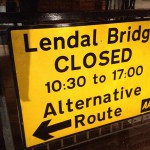Opposition Councillors have called in Labour’s £135,000 plan to establish a “Congestion Commission” in the City. The move means that an all party committee will decide whether the scheme will go ahead now or whether an alternative, providing better value for taxpayers, might be substituted after May’s elections.
The rethink request has the support of LibDem, Tory, Independent and Independent Labour Councillors.
The position of the two Green Councillors – who increasingly vote with Labour – is unclear.
It is an important consideration as, despite only holding 23 of the 47 council seats, the Green/Labour alliance has a majority on the committee which decides “calling in” applications.
The expectation, that the majority view on the Council (since it became “balanced” in October) would prevail, has been undermined by the new alliance.
Initially an inquiry into the Lendal Bridge fiasco was rejected, then the Greens sided with Labour in favour of “safeguarding” parts of the Green Belt for development and, most recently, they voted through the use of the Guildhall as a “digital media centre“.
The extent of the Greens confusion on the latter issue can be seen by a justification written by one of their Councillors on the web. He compares the Guildhall to the Barbican claiming that the media centre project is the only way of preventing it falling into disuse and decay.
His comparison with the Barbican is mostly based on a selective, and inaccurate, recall of history. The main reason that building was empty for several years was because of legal action, taken by a group of residents, to try to prevent the building being sold to the private sector.
There may be a clue there for the future of the Guildhall. With the published plans showing “workstations” being established in the old Guildhall itself, the associated infrastructure work is highly likely to prompt similar legal action.
Labour’s plan for the Guildhall also includes a bar and restaurant – the kind of uses that could only exacerbate the “party city” issues which afflict the center of York.
The planned £1.8 million overhaul of the Mansion House will attract more tourists to the area. They will expect to be able to access the historic Guildhall.
Much better, in our view, therefore to redevelop the 60’s office block (currently hidden from view) and use the revenue generated from that to sustain the fabric of the listed building, while ensuring continued public access.
So why are the Greens supporting Labour policies?

The reason is that they see the most likely wards in which they can make progress (and the biggest threat to their retaining their Fishergate stronghold) are those with Labour Councillors. They have their eyes on Micklegate and Guildhall. If they can reduce the number of issues on which there is open policy conflict they hope that the, largely untested, Green candidates will be the default choice for left leaning voters wanting to reject the unpopular, or ailing, sitting Councillors.
They hope to deflect attention away from their more extreme policies (they were bigger fans of the Lendal bridge closure and the introduction of indiscriminate 20 mph speed limits than many of their Labour counterparts).
So the majority of the Council will opt for a two stage approach to setting up a congestion policy review.
The first phase – in the lead up to May’s Council elections – would be to establish what is the most appropriate structure, consider options for membership and begin to gather, up to date, traffic data.
The real work could only begin after May 7th – by which time all of the existing members of the York Council may have lost their seats.



